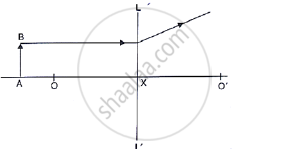Advertisements
Advertisements
प्रश्न
State the condition of the following:
A lens has both its focal lengths equal.
उत्तर
If the medium on both sides of the lens is same, the first and second focal lengths are equal.
APPEARS IN
संबंधित प्रश्न
State the condition when a lens is called an equi-convex or equi-concave.
A ray of light incident on a lens parallel to its principal axis, after refraction passes through or appears to come from ______.
Study the diagram shown in Fig. 5.56
Complete the diagram to show the formation of image A’B’ of the object AB of same size.

A ray of light incident parallel to the principal axis of a lens, passes undeviated after refraction.
Fig shows an object PQ placed on the principle axis of a lens L. The two foci of the kens are F1 and f2. The image formed by the lens is erect, Virtual and dimnished.

(i) Draw the outline ofthe lens L used and Named it.
(ii) Draw a ray of light starting from Q and passing through O. show the same ray after refraction by the lens.
(iii) Draw another ray from Q Which is incident parallel to the principle axis and show how it emerges after refraction from the lens.
(iv) Locate the final image formed.
In the following diagram the object and the image formed by the respective lenses are shown. Complete the ray diagram, and locate the focus. Find the focal length of the lens.

How will you differentiate between a convex and a concave lens by looking at a printed page?
Name the subjective property of light related to its wavelength.
Complete the following diagram and state what happens to the ray of light after refraction through the lens.

